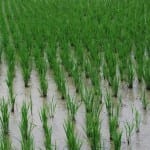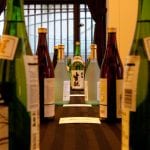 Yamada Nishiki is the king of sake rice. Not undisputed, mind you, and surely not the only game in town. But it is the most widely used sake rice by far. This is because it will cooperate; the toji can coax Yamada Nishiki to his or her preferences more easily than other sake rice varieties.
Yamada Nishiki is the king of sake rice. Not undisputed, mind you, and surely not the only game in town. But it is the most widely used sake rice by far. This is because it will cooperate; the toji can coax Yamada Nishiki to his or her preferences more easily than other sake rice varieties.
Readers likely recall that the connection between the choice of rice in the final flavor in sake is not nearly as tight as the connection between a grape varietal and the final wine. But the connection is, in fact, there. And its importance is buoyed by the above mentioned truth: that great sake rice just makes it easier to make great sake.
As such, each year, more and more Yamada Nishiki is grown. And this ends up making it good for rice growers too. Rice farming is a tough, tough business, and farmers will choose to grow rice that shows a combination of ease of growing, profitability, and liquidity on the market. Sure, some like a challenge – and some will try new rice types or less commonly seen varieties. But most rice producers have enough to think about. Since Yamada is easy to sell and many are more familiar with how to grow it, should a producer choose to mess with sake rice at all, and furthermore should the producer be in a region in which it can be grown, Yamada Nishiki is a safe choice.
What this means, though, is that some lesser known, cool varieties of sake rice are beginning to fall by the wayside. In other words, it is getting harder for brewers – not impossible, just harder – to get some less popular varieties of sake rice.
More specifically, since sake rice needs to be inspected, there needs to be inspectors on hand that maintain familiarity with each rice. With hundreds of rice strains being grown, each prefecture has a list of “recommended” strains from which rice producers can choose. Should a farmer choose one not on that list, he or she would not receive subsidies for growing it. This of course drastically lessens motivation to grow a non-recommended rice.
The above point just scratches the surface of the byzantine world of rice growing and distribution in Japan. Backing gingerly away from that deep rabbit hole, the point is that there are “lesser grown” rice varieties that are removed from the “recommended” list, making it practically impossible for local brewers to source those rice strains.
 Of course, the Agricultural Cooperatives behind this have their rationale. If only one farmer is growing only one field of a rice strain for just one sake brewer making one tank, it is simply infeasible and unreasonable to expect the powers that be to maintain that varietal on the inspection list. We all have to prioritize. Point being, there are no bad guys here. It is what it is. But I digress.
Of course, the Agricultural Cooperatives behind this have their rationale. If only one farmer is growing only one field of a rice strain for just one sake brewer making one tank, it is simply infeasible and unreasonable to expect the powers that be to maintain that varietal on the inspection list. We all have to prioritize. Point being, there are no bad guys here. It is what it is. But I digress.
As one case in point, a brewer about whom I wrote last month explained at a tasting of his sake that two products of his had been discontinued, those being sake made with Yamadaho rice and Tankan Wataribune rice. Why discontinued? Because the local Agricultural Co-op had taken them off the recommended list, and so no one in the prefecture wanted to grow them.
While they did not, obviously, constitute a major part of that kura’s production, it is still kind of a drag. Why? Because Yamadaho and Tankan Wataribune are the parents of Yamadanishiki. They were crossbred in 1936 in Hyogo Prefecture, and the result was the most widely used sake rice today. And it was cool to have available from the same kura a sake made with each parent, and one made from the child. It made for very cool comparative tasting. But alas; those days are gone.
What is not clear is whether or not this is the harbinger of a bigger problem, or if it is just an isolated anomaly. Will other lesser known rice varietals become harder to get? Or is this just something that happened in Miyagi Prefecture one time? Something tells me that it will be a reality somewhere between these two extremes. Let us keep our attention piqued.
Sake Professional Course
 The next Sake Professional Course will be held in Miami, Florida in September.
The next Sake Professional Course will be held in Miami, Florida in September.
The content of this intensive sake course will be identical to that of the Sake Professional Course held each January in Japan. The course is recognized by the Sake Education Council, and those that complete it will be qualified to take the exam for Certified Sake Specialist, which will be offered on the evening of the last day of the course.
You can read Testimonials from past participants here.
If you would like to make a reservation or to be placed on the notification list, please send an email to that purport to sakeguy@gol.com.




